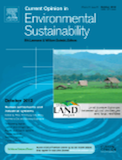
3Abstract: The carbon to nitrogen response of forest ecosystems depends on the possible occurrence of nitrogen limitation versus possible co-limitations by other drivers, such as low temperature or availability of phosphorus. A combination of nitrogen retention estimates and stoichiometric scaling is used to illustrate the most likely carbon–nitrogen responses for needle-leaved and broadleaved forests to atmospheric nitrogen deposition. Results are evaluated against field observations and nitrogen addition experiments. The likely change in carbon to nitrogen response with nitrogen deposition level is hypothesized, distinguishing three threshold values that mark the forest carbon responses. We estimated that at global scale nitrogen deposition currently increases the forest carbon sink by 276–448 Tg C yr−1, with approximately 60% retained in tree wood and 40% in soil. Furthermore, the long-term carbon response to nitrogen, accounting for nitrogen saturation over time is hypothesized. In this context, the role of global scale coupled carbon–nitrogen models is also evaluated in view of current knowledge affecting carbon–nitrogen responses, including interactions with other drivers.








